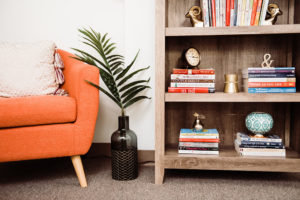It’s that time of year again where the enthusiasm from the New Year has waned and you find yourself fighting the winter blues. The temperature is painfully low, the snow has taken over the city, and sunny days feel really far away. When the environment feels like this, it can be hard to find the motivation to do much. If this sounds familiar to you, you’re not alone.
You might be dealing with Seasonal Affective Disorder…
Seasonal Affective Disorder is real and typically hits people right at this time of the year. It’s caused by a number of factors, but usually occurs in the winter when there is less sunshine. Symptoms of Seasonal Affective Disorder (or SAD, as we call it sometimes) can mirror symptoms of depression. If you’re dealing with SAD, you might find yourself sleeping more than usual, having less energy, withdrawing from social interactions, or struggling with motivation and productivity.
So what can you do in the dead of winter if you’re dealing with SAD? Believe it or not, there are a number of things that can help you beat these winter blues, even if sunny days are still a few months away. We’ve put together this short list of simple tips to help overcome some of the depressive symptoms you might be feeling related to SAD.
Stay Active
You can probably find this tip in almost every blog we write because it’s so helpful as a mood booster. Exercise and other movement-oriented activities get the blood pumping through our bodies and the feel-good chemicals pumping in our brains. Because of this physiological phenomenon, working out or exercising is a quick and easy way to lift your spirits.
Believe it or not, you don’t need to do much to reap the benefits of being active. Even a short walk around the block or a quick dance party in your living room can get the feel-good chemicals flowing and have a positive impact on your mood.
Be Social
In some ways, symptoms of SAD are similar to the hibernation activities that animals naturally turn to. Behaviors like isolating yourself, staying in your warm bed, and sleeping a lot are all symptoms of SAD. Unfortunately, most of us can’t spend months at a time curled up under the covers, so we have to find ways to fight these urges.
Making plans with other people can help. As humans, we’re wired for connection and relationships. Staying connected to others, even when you’re not feeling especially social, is another way to boost the feel-good chemicals in your brain and help you fight SAD symptoms. Game nights with friends, weekly family dinners, and workout buddies are all great ways to stay connected to your social circle during the winter months.
Spruce Up Your Home
Our indoor environment can have a positive impact on our mood, even when we’re feeling unmotivated. It’s true that nobody feels like doing chores when they’re feeling unmotivated, but if you start small it can help. Pick one simple task to do – maybe it’s putting the dishes from the sink into the dishwasher, folding ten pieces from the clothes that have been in the dryer for a few days, or picking up the toys from just one room in your home. It doesn’t have to be perfect, but even small things like this can help.
You can also create an ambiance in your home that makes you feel good. By creating a space you enjoy being in, you can turn your mood from sad and isolated to warm and cozy. Some of our favorite ways of creating this ambiance is burning candles, using warm lighting, having fuzzy blankets to use, and playing your favorite music.
Light Therapy Lamps
It is believed that one of the leading causes of SAD during the winter is limited exposure to sunlight. It can be hard to boost your exposure to natural sunlight during these cold months so you can try something called a light therapy lamp, which mimics natural sunlight conditions. This New York Times article did all the research to find the best light therapy lamp.
As it says in this article, light therapy lamps are technically a medical device and we recommend using one under the care of a doctor.
The winter season can sometimes be difficult to weather (pun intended), but if your SAD symptoms are affecting your ability to function, help might be in order. In addition to the tips listed above, you can always make an appointment to come in and work with one of our therapists. Even if your symptoms are seasonal, working with a therapist can help you build and strengthen valuable coping skills to get you through these winter months. And the best part is, the coping skills you develop in therapy will still be helpful once these winter blues are over!
If you’d like some extra support this winter, contact us today to schedule a time to meet with one of our therapists. We’re here for you and we’d love to help.
Photo by Ivan Samkov from Pexels

 Nicolle Osequeda, LMFT, is the founder of Lincoln Park Therapy Group, specializing in anxiety, depression, and relationship counseling in Chicago. As a Certified Daring Way™ Facilitator, she incorporates Dr. Brené Brown’s research into her therapy. Nicolle holds a Master’s in Counseling Psychology from the University of San Francisco and is a Licensed Marriage & Family Therapist in Illinois and California. She is a Clinical Fellow of AAMFT, a member of IAMFT, and the Financial Therapy Association. Nicolle has Gottman Method training and has taught at DePaul University, dedicated to helping individuals and couples achieve meaningful change.
Nicolle Osequeda, LMFT, is the founder of Lincoln Park Therapy Group, specializing in anxiety, depression, and relationship counseling in Chicago. As a Certified Daring Way™ Facilitator, she incorporates Dr. Brené Brown’s research into her therapy. Nicolle holds a Master’s in Counseling Psychology from the University of San Francisco and is a Licensed Marriage & Family Therapist in Illinois and California. She is a Clinical Fellow of AAMFT, a member of IAMFT, and the Financial Therapy Association. Nicolle has Gottman Method training and has taught at DePaul University, dedicated to helping individuals and couples achieve meaningful change. 

